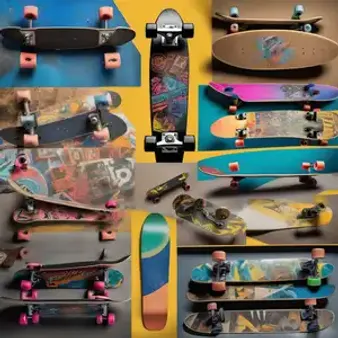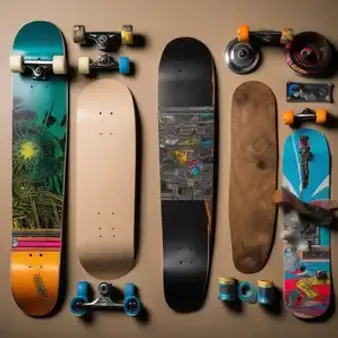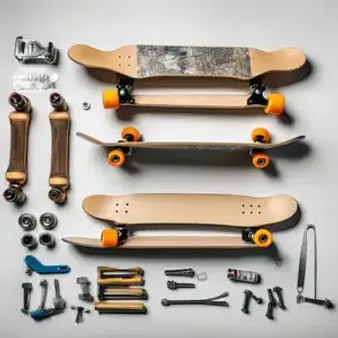Table of Contents
Ready to ride? Whether you're a seasoned skater or just starting out, planning your skateboard setup is key to a smooth and enjoyable experience. At kizworld, we're passionate about helping you find the perfect plan skateboard for your needs.
Factor | Consideration |
|---|---|
Skill Level | Beginner, intermediate, or advanced? |
Riding Style | Street, park, vert, cruising? |
Deck Shape & Size | Width, length, and concave affect stability and control. |
Trucks | Size should match deck width; looseness impacts turning. |
Wheels | Size and hardness affect speed, grip, and ride smoothness. |
Plan Skateboard Shapes and Sizes
Picking the right plan skateboard shape and size is super important for how well you can ride. It's like choosing the right pair of shoes for playing your favorite sport! Imagine trying to play basketball in ice skates – not a good idea, right?
First up, let's talk about shapes. Skateboard decks, the wooden part you stand on, come in different shapes like popsicle (the most common), cruiser, and old-school. Popsicle decks are great for beginners because they're stable and good for learning tricks. Cruiser boards, as the name suggests, are awesome for cruising around, with a more comfortable shape for longer rides. Old-school decks have a wider nose and tail, making them cool for transition skating (think ramps and bowls). Check out this beginner's guide to skateboarding for more tips.
Shape | Best For |
|---|---|
Popsicle | Beginners, street skating, tricks |
Cruiser | Cruising, transportation, comfortable rides |
Old School | Transition skating, ramps, bowls |
Now, let's talk size! Deck width is measured in inches, and it's a big deal for foot placement and control. For younger or beginner skaters, a narrower deck (7.5"- 8") can be easier to handle. If you have bigger feet or want more stability, go for a wider deck (8.25" and up). It's like Goldilocks finding the perfect porridge – you want a size that feels "just right" for you!
Remember, choosing the right plan skateboard shape and size is all about finding what works best for your height, foot size, and riding style. Don't be afraid to experiment and try out different options to see what you like. After all, skateboarding is all about having fun and expressing yourself! For more in-depth info, take a look at this guide on choosing the right skateboard for your skill level.

Plan Skateboard Shapes and Sizes
Choosing the Right Plan Skateboard for Your Skill Level
Picking the right plan skateboard for your skill level is like choosing the right superhero sidekick – it's gotta match your powers! If you're just starting out, you don't want a board that's too big or too advanced. It's like trying to learn to ride a bike on a unicycle – tricky! For beginners, a good skateboard for your skill is usually a bit shorter and narrower, making it easier to control. As you get better, you can move up to a bigger board with more features, kind of like how a superhero gets a cooler costume as they gain more experience!

Choosing the Right Plan Skateboard for Your Skill Level
Plan Skateboard Components: Decks, Trucks, and Wheels
Alright, let's break down the anatomy of your plan skateboard. Just like a superhero needs their gadgets, a skateboard needs its key parts: the deck, trucks, and wheels. Think of it like this: the deck is your stage, the trucks are your dance partners, and the wheels are your roller skates!
The Deck: Your Wooden Stage
The deck is the flat, wooden board you stand on. It's usually made of maple wood, which is strong and flexible, perfect for handling those epic tricks. Decks come in different shapes and sizes. For beginners, a wider deck offers more stability - like having training wheels on your bike. You can even customize your deck with cool graphics or your own artwork. It's like having your own signature style on wheels! For those interested in improving their skateboarding skills, check out this guide on how to improve balance.
Deck Width | Suitable For |
|---|---|
7.5" - 8" | Younger or beginner skaters |
8.25" - 8.5" | Most riders, good balance of stability and control |
8.5" and up | Larger riders, those who want more foot space |
Trucks and Wheels: Your Dance Partners and Roller Skates
Trucks are the metal parts that connect your wheels to your deck, and they let you steer and turn. Looser trucks mean sharper turns, but they can be a bit wobbly for beginners. It's like learning to ride a bike – you gotta find your balance first! Wheels come in different sizes and hardness levels. Softer wheels are grippier and smoother for cruising, while harder wheels are faster but might rattle your teeth on bumpy roads. Think of it like choosing the right shoes for running – you want something comfy and supportive! If you are interested in finding the right equipment, you might want to check out this article about the best skateboarding equipment and accessories.
- Softer wheels (78A-87A): Best for rough surfaces, cruising, and beginners
- Harder wheels (99A - 101A): Best for speed, tricks, and smooth surfaces

Plan Skateboard Components: Decks, Trucks, and Wheels
Building Your Custom Plan Skateboard: A StepbyStep Guide
Alright, so you've got the lowdown on plan skateboard shapes, sizes, and parts. Now, let's get our hands dirty (not literally, we just washed them!) and talk about putting it all together. It's like building a LEGO masterpiece, but instead of ending up in pieces at the bottom of your toy bin, you end up with a rad ride.
Assembling the Puzzle: Attaching Trucks and Wheels
First things first, grab your deck, trucks, wheels, bearings, hardware (those little screws), and a skate tool (your new best friend). Think of the skate tool as your superhero utility belt - it has everything you need to tighten, loosen, and adjust your board. Now, carefully put your trucks on your deck - they fit snugly on those little holes. Next up, slide those bearings into your wheels. They're like tiny donuts that help your wheels spin smoothly. Now, pop those wheels onto the trucks' axles and tighten the nuts. But remember, not too tight! You want your wheels to spin freely, not get stuck in a traffic jam.
Component | Function |
|---|---|
Deck | The wooden platform you stand on |
Trucks | Metal parts that connect the wheels to the deck |
Wheels | Provide the roll and grip for your board |
Bearings | Tiny metal rings that allow wheels to spin smoothly |
Hardware | Screws that attach the trucks to the deck |
For more on skateboard maintenance, check out our guide on how to improve balance.

Building Your Custom Plan Skateboard: A StepbyStep Guide
Final Thought
Building your own plan skateboard is a rewarding experience that lets you personalize your ride. From choosing the right deck to assembling the components, each step plays a crucial role in creating a board that reflects your style and skill. Remember, practice makes perfect, so get out there, ride, and enjoy the journey!